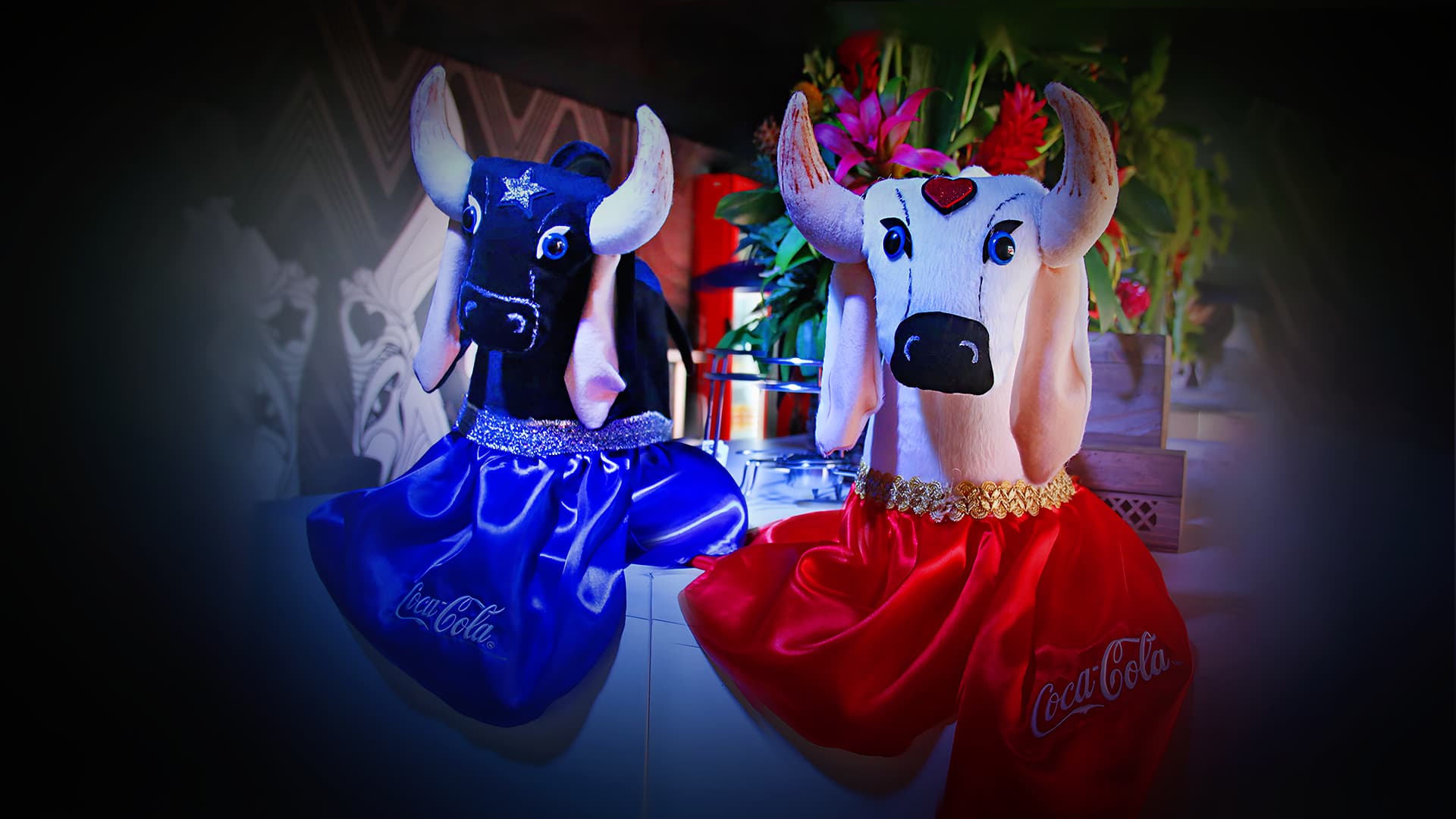The story that inspires festivities throughout Brazil narrates the adventures of Father Francisco and his wife, Mother Catirina, who, being pregnant, wants to eat beef tongue. To satisfy his wife’s wishes and ensure his son’s health, Father Francisco kills the best ox in the farm, arousing his boss’s wrath.
The lord of the farm threatens Father Francisco with punishment: if he doesn’t get his best ox back in one day, Father Francisco and the whole family will suffer tragic consequences. Thanks to divine intervention, Father Francisco and Mother Catirina achieve a real miracle: they bring the ox back to life, giving rise to one of the most famous folk festivals in the whole country.
Celebrated throughout Brazil, the Boi (ox) varies in each region, taking on different names, rhythms, formats, costumes and characters.

In some regions, Father Francisco is presented as enslaved… In others, he is a cowboy. He can also be called Chico or Mateus, and Mother Catirina can be Catarina. Also depending on the locality, the person who investigates the disappearance of the ox is the chief of police or the chief cowboy… And, those looking for Chico are the colonel’s henchmen or the indigenous people. The person who helps the ox to revive is a Doctor, a Priest or a Shaman.
In Parintins, the heart is blue and red… And it beats the maddening rhythm of the most celebrated animals: the oxen of the Amazon ritual!
Every year, the city hosts an unforgettable event… One that gives rhythm and majesty to the Bumbodromo, where the Caprichoso and Garantido oxen compete for the hearts of thousands of fans. Six thousand revelers known as brincantes vibrate to the sound of tunes, exalting nature with choreographies, rhythms and visual elements that reflect the enthusiasm of the local population for the mysteries of the largest forest in the world.

Boi Garantido (the Garantido ox) is white with a red heart on its forehead. It was born in 1913, on the old Estrada Terra Santa, in downtown São José. Little Lindolfo Monteverde, then 11 years old, heard several stories from his grandfather.
One of them talked about an ox that danced to amuse adults and children. Inspired, Lindolfo created a fabric-covered frame and went out playing with his “Boi Bumbá”. Years later, Lindolfo fell ill and made a promise to Saint John the Baptist: If he got better, his little ox wouldn’t stop going out on the street as long as he was alive. Since then, every year, from the 30th of April to the 1st of May, the brincantes go out into the streets of Parintins announcing the beginning of the festivities.
Boi Caprichoso (the Caprichoso ox) is black with a blue star on its forehead. It was founded in 1913 by Roque da Silva Cid who was 33 years old at the time. Born in the city of Crato, Ceará, Roque arrived in the city of Parintins in mid-1897.
After listening to his friend José Furtado Belém talk about an ox party he had seen in 14 Square, in Manaus, Roque and his brother Antônio Cid brought their friends together for a great game. Over time, the celebration gained notoriety and became known in the history of the Parintins Boi-Bumbá.

For three nights, the fascinating clash takes place at the Parintins Cultural Center, popularly called Bumbodromo, an arena in the stylized shape of an ox head. With 25,000 seats, the arena is the stage for the dispute between the Caprichoso and Garantido oxen that alternate on stage, providing more than 4 hours of daily dazzling celebration. More than 2,500 brincantes of each ox with costumes, props, choreography, allegories and different tunes create a different party every night. Fireworks, electronic effects, laser shows, sophisticated gears and gigantic floats add up to make this one of the most beautiful parties in the world.
Standard Bearer:
The moving symbol of the Boi (ox). With determination, resourcefulness and a lot of sympathy, she dances with the banner that carries the symbol and colors of the boi-bumbá.
Cunhã-Poranga:
The most beautiful indigenous woman in the tribe. With a warrior spirit, she expresses in her dance the feelings of love and passion. Its beauty reflects all the uniqueness of the native women of the Amazon.
Queen of Folklore:
The representative of the popular demonstration extols respect for nature and takes spectators to the magic of playing the Boi in tune with the cultural diversity of the forest.
Pajé:
Healer, shaman and priest, he is the balance point of the tribes. He plays indigenous rites and legends. In the narrative, he is the one who resurrects the ox that had its tongue cut out by Father Francisco in response to Mother Catirina’s wish.
Amo do Boi:
The farm owner. It is he who keeps alive the tradition of the party with rivalry behind poetry in the form of verses. His emblematic figure was inspired by the Northeastern heritage of repente lyrical duels and improvisation.
Sinhazinha da Fazenda:
The farm owner’s daughter. In her presentation, she displays an outfit that represents all the wealth of the dresses wore by women of colonial times.
Boi Bumbá:
The big star of the festival. Its participation is contagious to the people who wait all year to see it. The person who gives life to the cloth animal is known as the “tripa do boi” (ox’s gut), who plays under it, performing its choreographic evolutions.
Presenter:
The conductor who governs the entire native opera. Responsible for explaining each moment of the presentation and leading the crowd during the show, he leads the show with sounds, colors and joy.
Tune Lifter:
He is the one who sings the tunes during the presentations. Responsible for showing the harmony of Bumba with the crowd, the lifter conducts the musical spectacle of this native opera.